ASUS Vivobook S15 OLED Ft. Snapdragon X Elite Review: Better Than Intel Core Ultra 7?
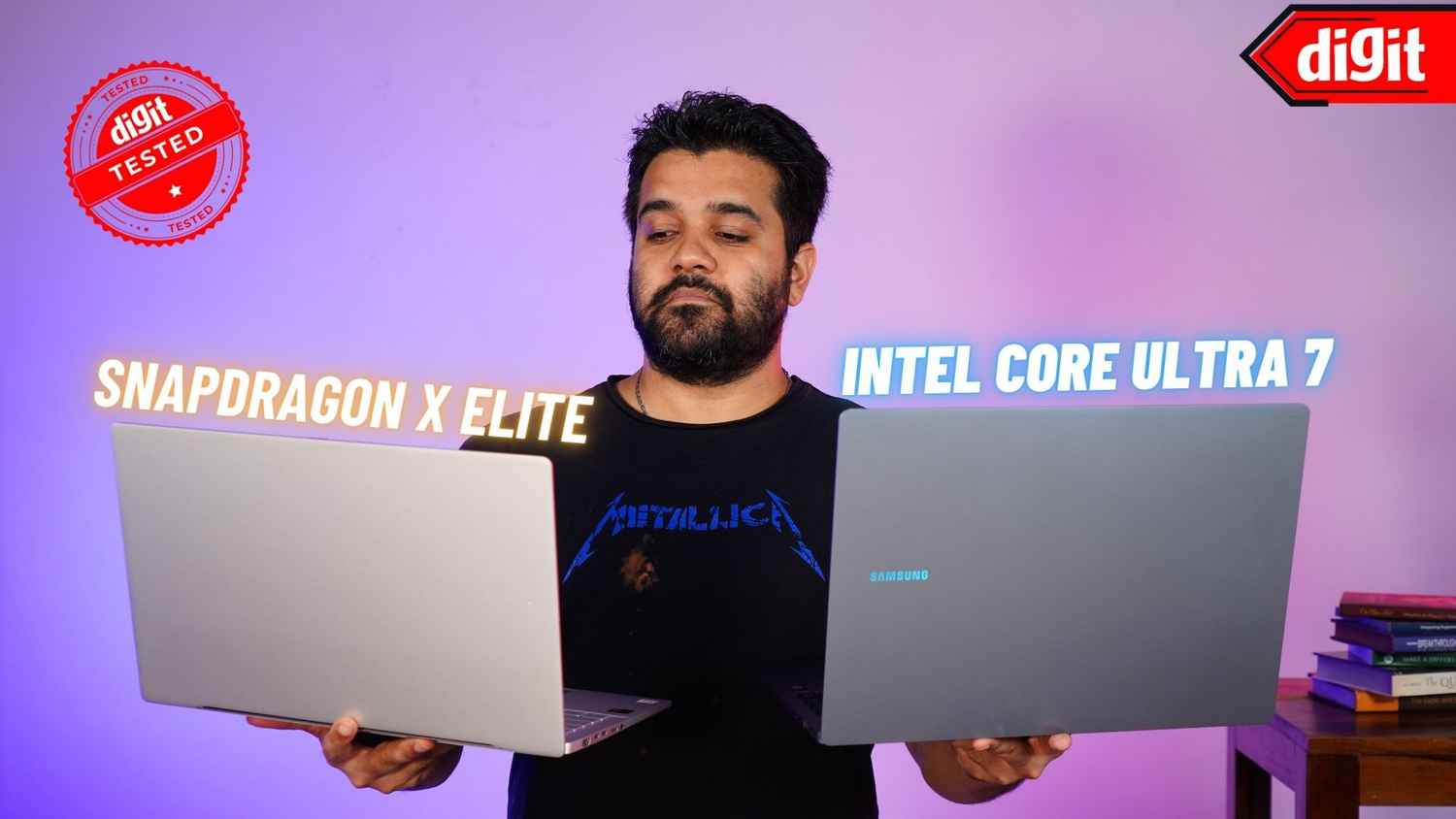
Windows on ARM is not new. Efforts began in 2012 with Windows RT, a version of Windows 8 for ARM. Over the years, significant developments were made, but none were of this scale where giants like Qualcomm, Microsoft, and other OEMs such as HP, Dell, ASUS, and more came together to create a comprehensive and competitive ARM-based Windows ecosystem.
This collaboration aims to deliver high performance, energy efficiency, and seamless compatibility, striving to challenge the dominance of traditional x86 architecture and push the boundaries of what ARM processors can achieve in the Windows operating environment.
For the uninitiated, ARM and x86 processors differ in their instruction sets. While the former uses the simpler RISC (Reduced Instruction Set Compute), the latter uses CISC (Complex Instruction Set Compute). ARM’s simpler, power-efficient design originated from ACORN computers’ goal to create a CPU with plastic packaging, leading to the development of the first ARM processor, ARM1.
Fun fact – ARM’s first name was ACORN RISC Machine – but on 27 November 1990 ARM would be renamed as Advanced RISC Machine following the joint venture of Apple, ACORN and VLSI technologies. Nearly 16 years later, Apple would launch the first iPhone in 2007 and then 14 years later it would launch the M1 chip, revolutionising computing on Mac forever. Fast forward to four more years and we have the Snapdragon X Elite, a chip built on the same CPU architecture as the Apple M1 SoC.
So, is the Snapdragon X Elite any good? And most importantly is it better than the current crop of X86 CPU chips from Intel and AMD that we have on the market today? Well, here’s my answer.
ASUS Vivobook S15 Snapdragon X Elite Review: Specifications
- Processor: Qualcomm Snapdragon X Elite SoC 12 threads and 12 cores up to 3.8 GHz max clock speed
- Graphics: Qualcomm Adreno up to 4.6 TFLOPS
- Memory: 16GB LPDDR5X running at 8448MHz
- Storage: 1TB PCIe Gen 4 SSD
- Display: 15.6-inch 3K 120Hz OLED
- Weight: 1.42 kg
- Battery Size: 70Wh
ASUS Vivobook S15 Snapdragon X Elite Review: Design, Build Quality, Keyboard and I/O Review
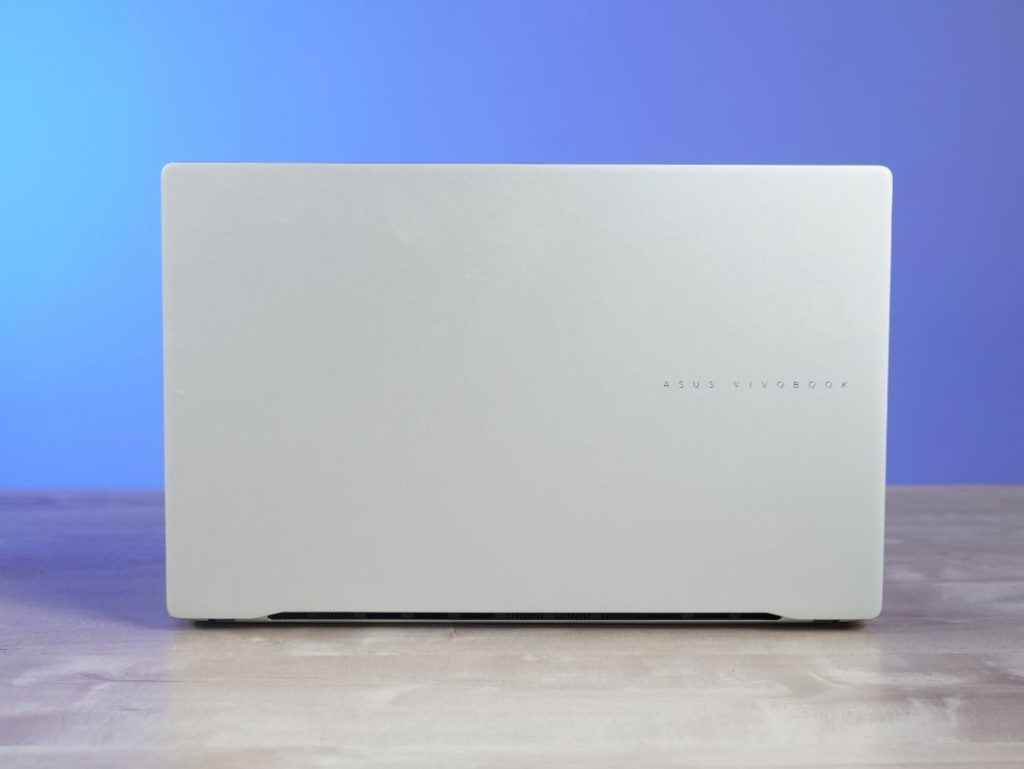
Although ASUS says that both their Intel-powered and Snapdragon-powered Vivobook S15s are the same in terms of build quality, but, I really feel that the Snapdragon X Elite-powered Vivobook S15 is built much better. Not only is its chassis more hardy the laptop’s display hinge is also sturdier.
Since we’re comparing the ASUS Vivobook S15 with the Intel Core Ultra 7-powered Samsung Galaxy Book 4 Pro, I’d like you to remember that the latter is at par or even better in terms of build quality. Its chassis feels more premium and its hinge’s movement is also more fluidic. Smooth, when you lift it and firm when you set it in any particular position.
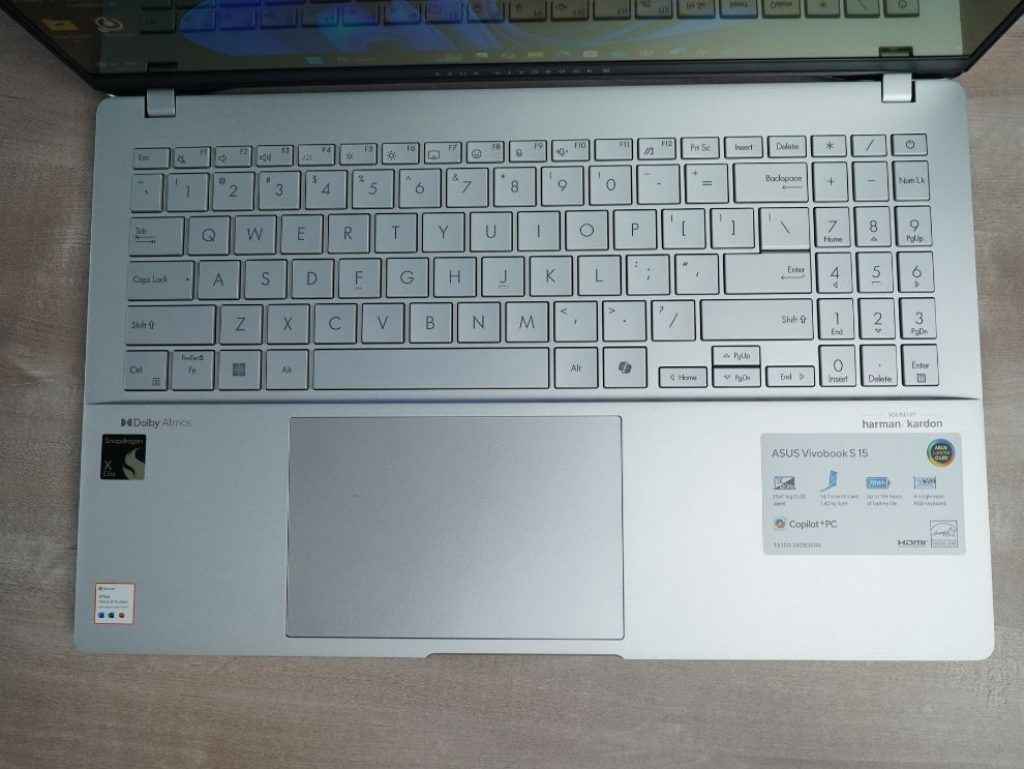
Back to the Vivobook S15 and in terms of keyboard, it is the same as its Intel-powered variant. But the touchpad on the Snapdragon X Elite version is different. It is smaller when compared to the Core Ultra 7 variant but its placement and clicks feel better in comparison. If you’ve used the ASUS ROG Strix G16 you’d find the touchpad on the S15 X Elite fairly similar.
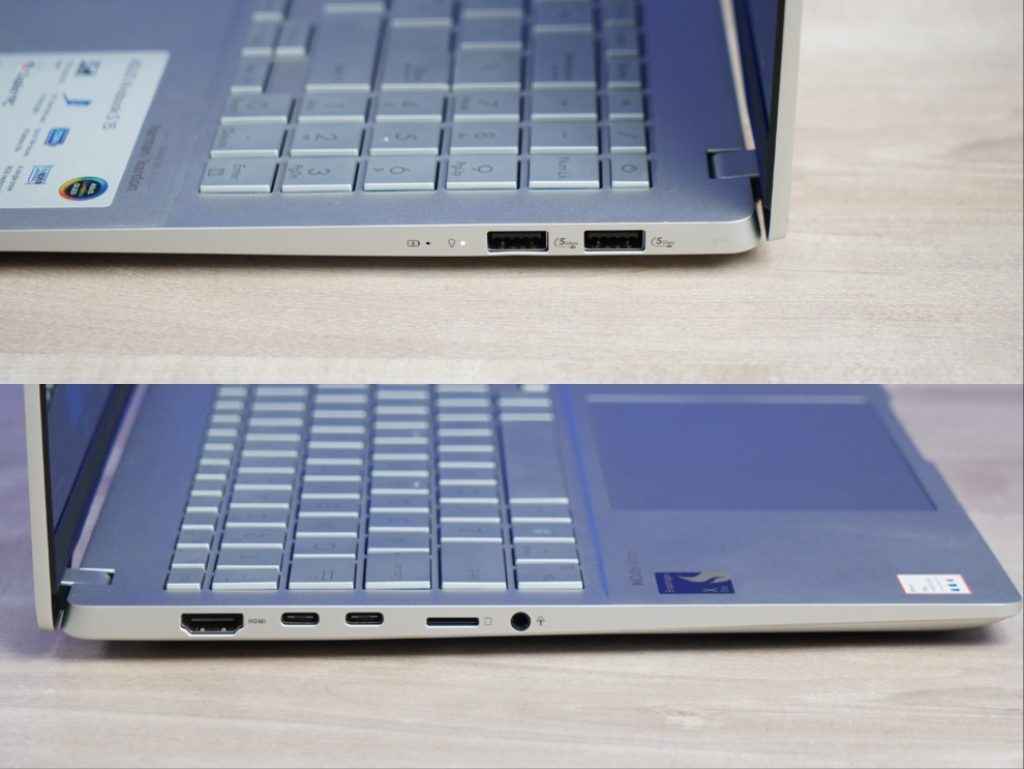
In terms of I/O ports, both laptops offer essential ports like HDMI 2.1, USB Type-A, USB Type-C, a 3.5 mm jack, and an SD card slot. The Vivobook lacks Thunderbolt 4, offering USB 4 instead. Now, the Thunderbolt 4 is objectively better but the USB 4 also has similar functionalities. Moreover, the Vivobook X Elite has one more USB Type-A port as well.
ASUS Vivobook S15 Snapdragon X Elite Review: Display And Speakers Review
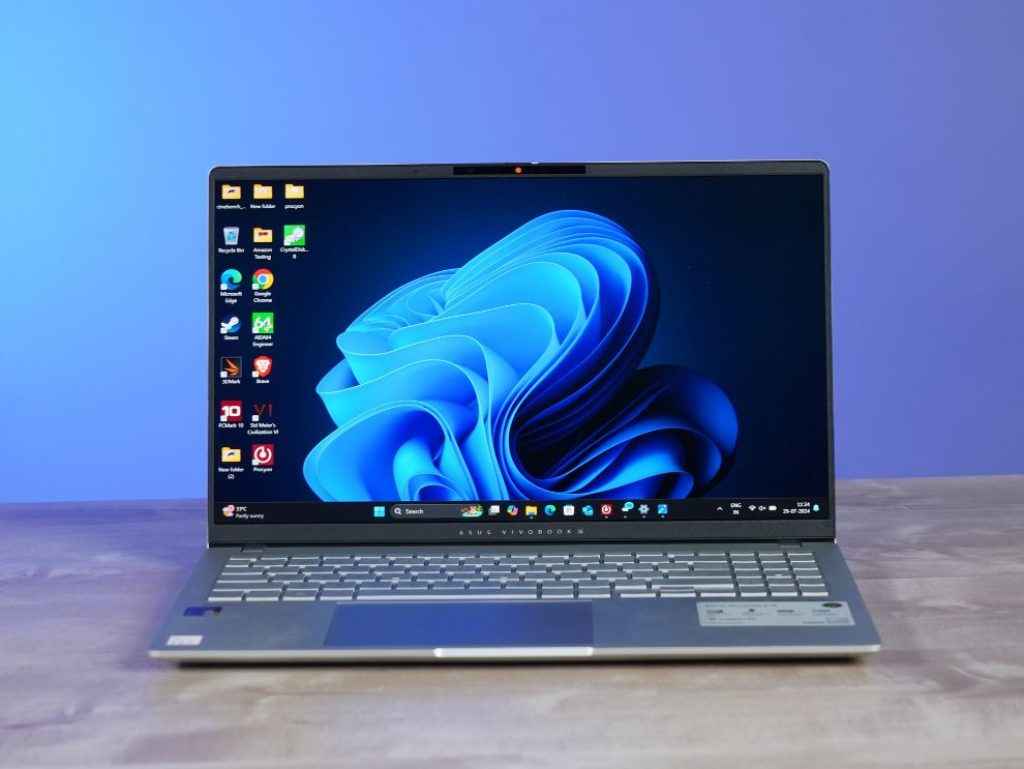
The Samsung Galaxy Book 4 Pro displays and the ASUS Vivobook S15 differ notably in their SDR brightness. The Galaxy Book 4 Pro has an SDR brightness of 385 nits, while the Vivobook S15 offers a slightly higher SDR brightness of 400 nits. This marginal difference is hardly noticeable as you’ll find both screens plenty bright.
Beyond SDR brightness, the displays of the Samsung Galaxy Book 4 Pro and the ASUS Vivobook S15 differ in several key aspects. The Galaxy Book 4 Pro excels in colour gamut coverage, offering a broader sRGB coverage of 167.8% and DCI-P3 coverage of 118.8%, which makes it particularly well-suited for tasks that demand high colour accuracy and a wide colour range, such as photo and video editing.
On the other hand, the Vivobook S15 covers approximately 133% of the sRGB gamut and 100% of the DCI-P3 colour space, providing excellent colour reproduction but slightly less extensive than the Galaxy Book 4 Pro. In terms of colour accuracy, both devices perform admirably, with the Galaxy Book 4 Pro achieving Delta E values of 1.4 for sRGB indicating very precise colour rendering. The Vivobook S15 maintains an average Delta E of around 1, which is slightly better.
The Samsung Galaxy Book 4 Pro features a solid audio setup with 2.2 speakers, comprising two 5W woofers and two 2W tweeters, and includes Dolby Atmos support, delivering a loud and clear sound experience around 80.4 dB. However, it falls short of the high standards set by Apple’s MacBook speakers, making it less ideal for media consumption without additional audio support.
In contrast, the ASUS Vivobook S15 with the Snapdragon X Elite variant also offers a decent audio experience. It features Harman Kardon-certified speakers with Smart Amp Technology, giving you a balanced and rich sound output suitable for everyday use and light media consumption. But still not up to the mark of an Apple MacBook.
ASUS Vivobook S15 Snapdragon X Elite Review: Battery Life And Efficiency
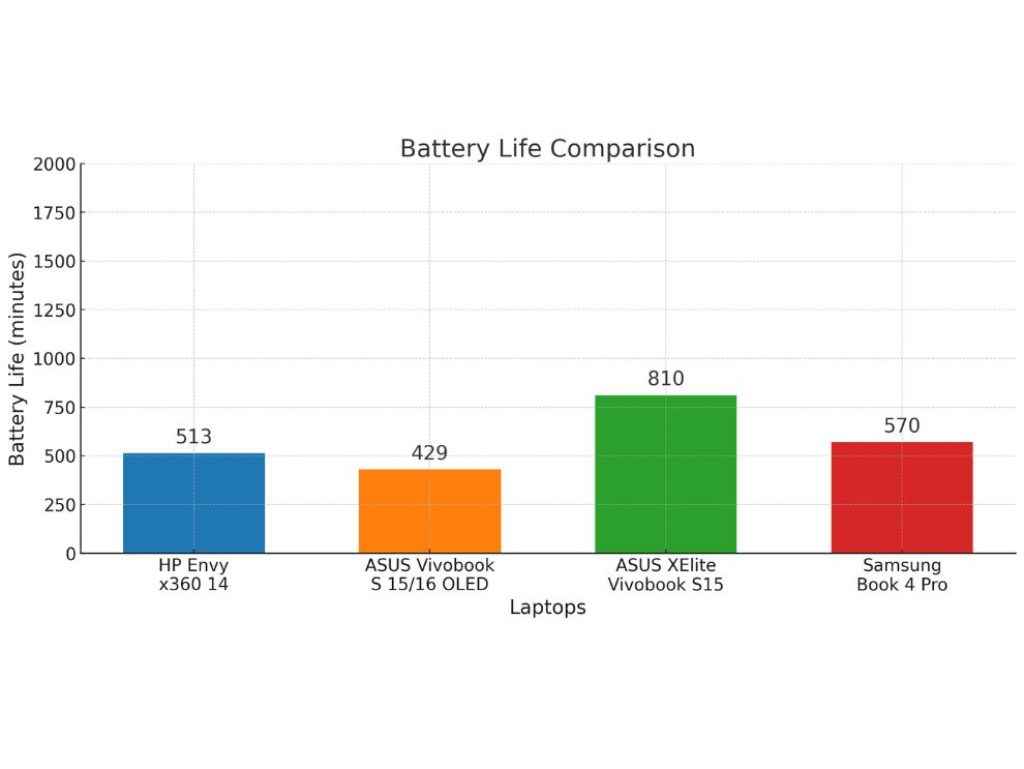
The ASUS Vivobook S15 (Snapdragon X Elite) significantly outperforms the Samsung Galaxy Book 4 Pro (Intel Core Ultra 7) in terms of battery life. The Vivobook S15 offers an impressive 810 minutes of battery life, compared to the Galaxy Book 4 Pro’s 570 minutes, providing an additional 240 minutes of usage. Both laptops offer adjustable power modes, but the Vivobook S15 stands out with its range from Whisper Mode at 20W to Full Speed Mode at 50W. This flexibility allows users to balance performance and battery efficiency effectively.
In contrast, the Galaxy Book 4 Pro is capped at a maximum power of 28W; this information will become relevant once again in the performance section. But with that said, the ASUS Vivobook S15 wins in terms of battery life.
ASUS Vivobook S15 Snapdragon X Elite Review: Performance And Benchmarks
One of the big claims of the Snapdragon X Elite chip is its identical performance on battery life and when plugged in. And after testing the chip thoroughly I can easily say that it is true but with some caveats and exceptions which neither Microsoft nor Qualcomm are telling you in detail.
A lot of Windows applications, including games, are only able to work on the Snapdragon X Elite ARM CPU through an emulation layer called PRISM. Yes, you heard that right. And just like any other emulator, there is a performance loss. This performance loss isn’t too big usually, but in some specific cases, it sticks out like a sore thumb. For instance, when plugged in, the X Elite scored 13968 points in the Geekbench 6 Multicore test but came down to 7312 when running on battery power.
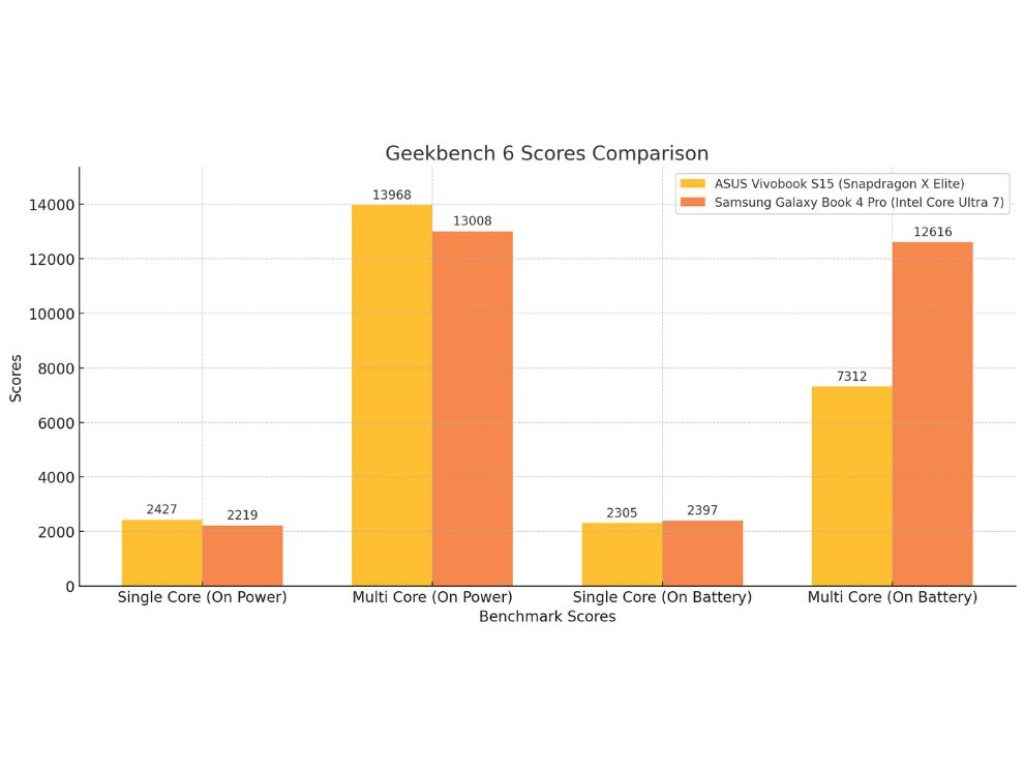
Even while running Cinebench R23, the X Elite suffers from some performance loss, scoring 8,870 in the multicore test when on battery instead of 13,492 when plugged in. But when an app is optimised specifically for ARM, X Elite-powered Vivobook S15 performs extremely well, even beating the Intel Core Ultra 7 as well.
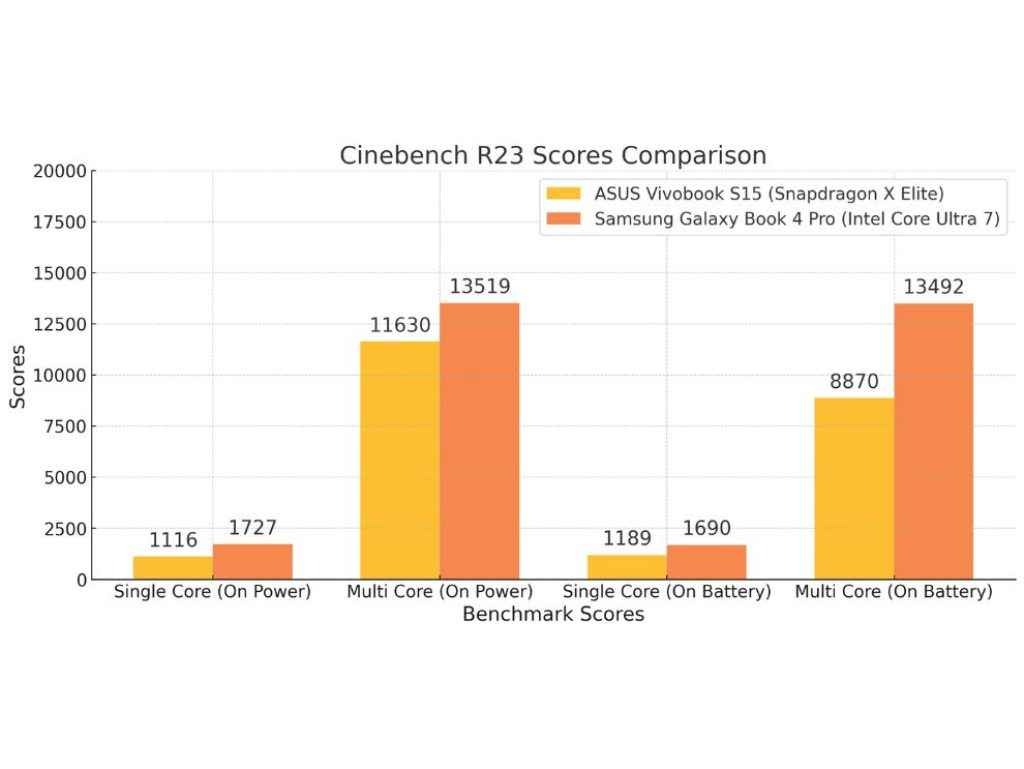
In Cinebench 2024, which has an ARM-optimized version, the Snapdragon X Elite scored 1,114 when plugged in and 1,049 when on battery. Although the Intel Core Ultra-powered Samsung Galaxy Book 4 scored lower, around 746 and 703 on power and on battery respectively, the performance difference in both these cases is very small.
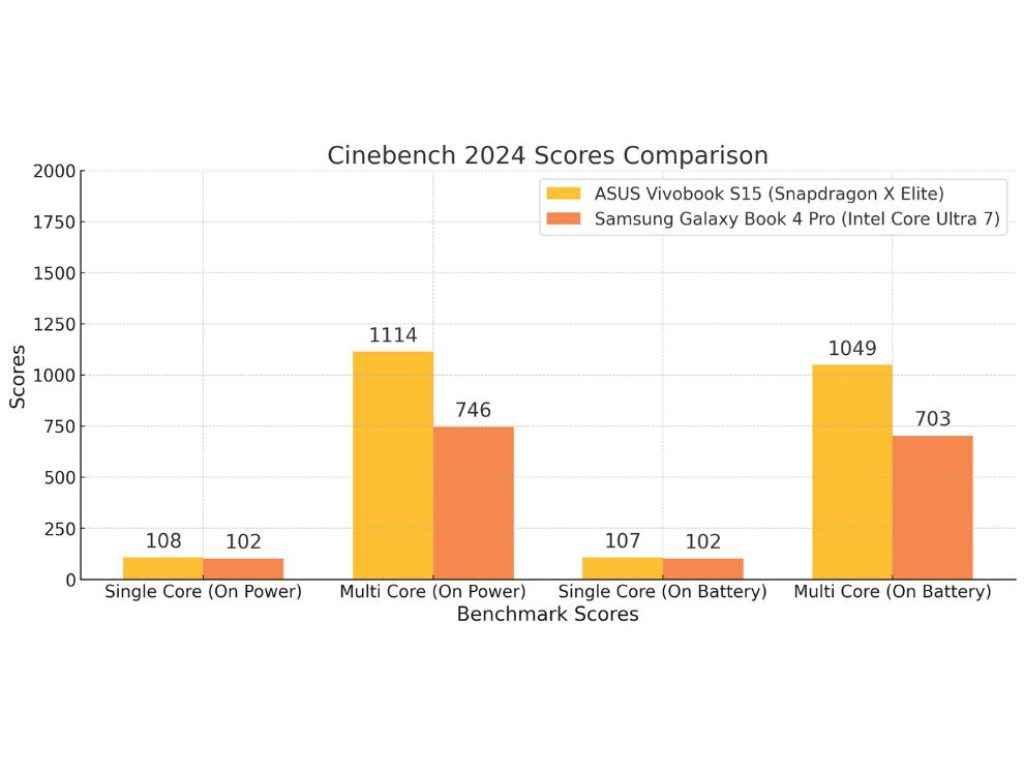
The ASUS Vivobook S15 stands out in both memory performance and latency compared to the Samsung Galaxy Book 4 Pro and the 14-inch MacBook Pro M3 Max. The Vivobook S15 achieves a memory read speed of 116,600 MB/s, outperforming the Galaxy Book 4 Pro’s 81,489 MB/s by 43.1%. Although the Galaxy Book 4 Pro has a slight advantage in memory write speeds (73,543 MB/s vs. 64,391 MB/s), the Vivobook S15 excels overall.
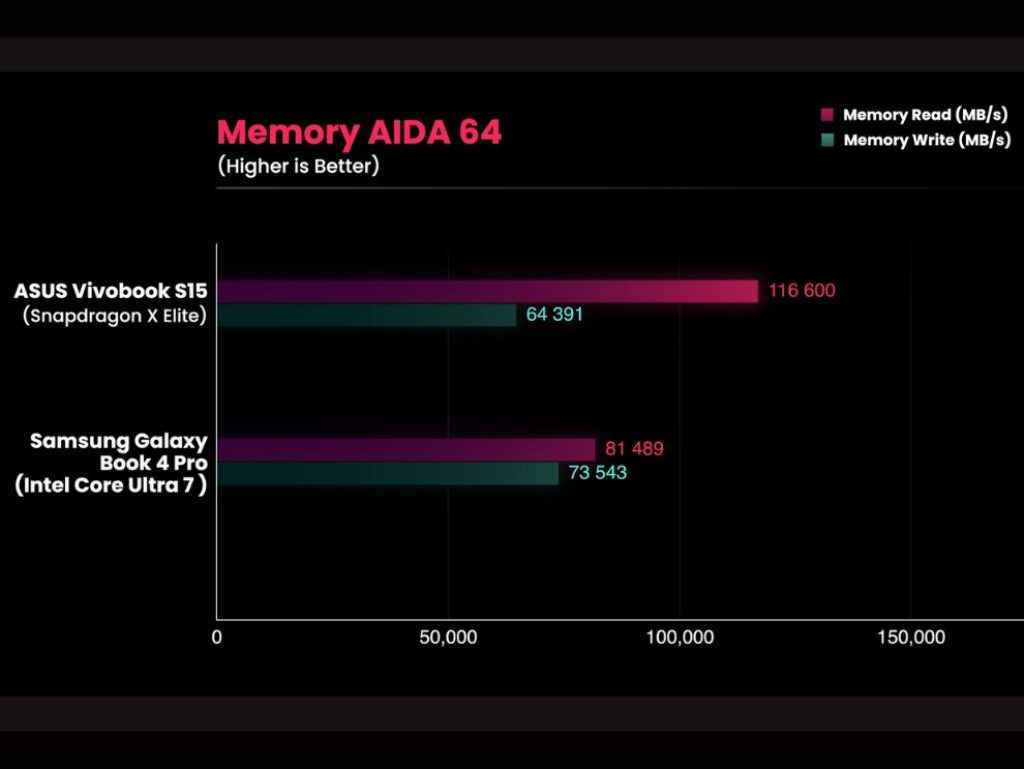
In terms of latency, the Vivobook S15 X Elite has the lowest latency at 9.7 ns, compared to the MacBook Pro M3 Max’s 18 ns and the Vivobook S15 (Intel)’s 178.6 ns. This makes the Vivobook S15 (Snapdragon X Elite) the best choice for tasks requiring quick memory access and superior performance, outperforming the Galaxy Book 4 Pro and the MacBook Pro M3 Max.
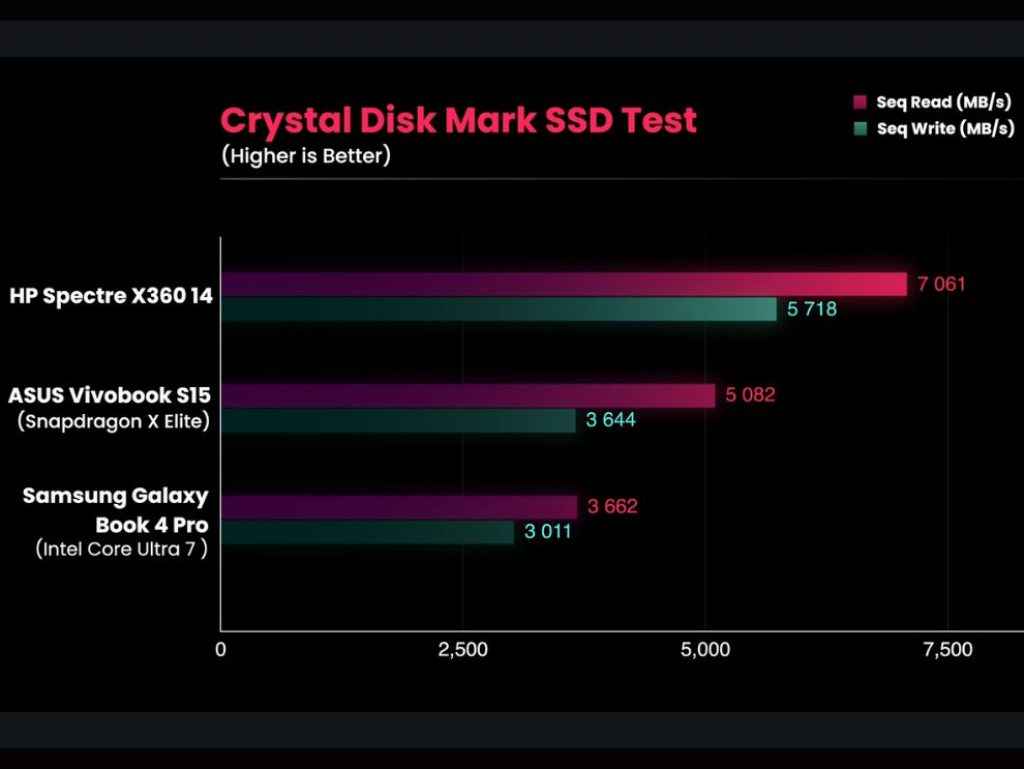
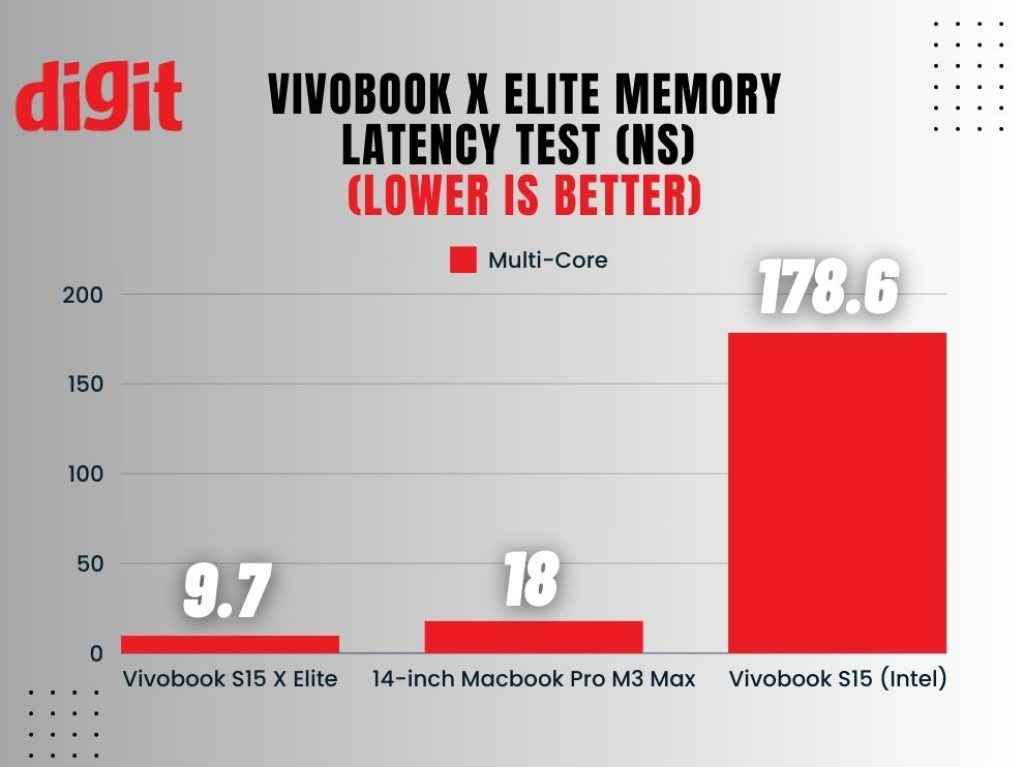
The ASUS Vivobook S15 significantly outperforms the Samsung Galaxy Book 4 Pro in graphics performance. With its Qualcomm Adreno GPU, the Vivobook S15 scores 4207 in the 3d Mark’s TimeSpy benchmark and 8931 in FireStrike, compared to the Galaxy Book 4 Pro’s 1900 in TimeSpy and 6129 in FireStrike. These results show that the Vivobook S15 achieves more than double the performance in TimeSpy and substantially higher scores in FireStrike, thus proving that Qualcomm Adreno GPU still has some way to go.
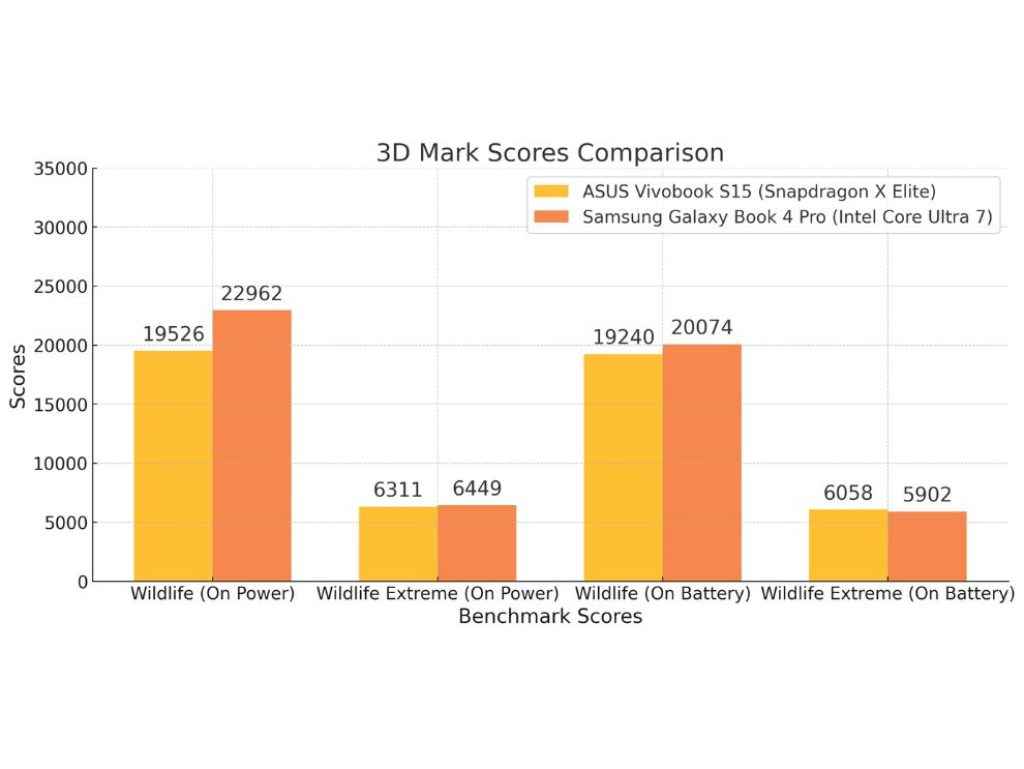
The same became even more apparent when I tried to run some gaming benchmarks at 720P low settings. In Shadow of the Tomb Raider, the Galaxy Book 4 Pro slightly outperforms the Vivobook S15, achieving 45 FPS on power compared to 42 FPS on the Vivobook S15. On battery, the difference narrows with the Galaxy Book 4 Pro scoring 42 FPS and the Vivobook S15 at 41 FPS.
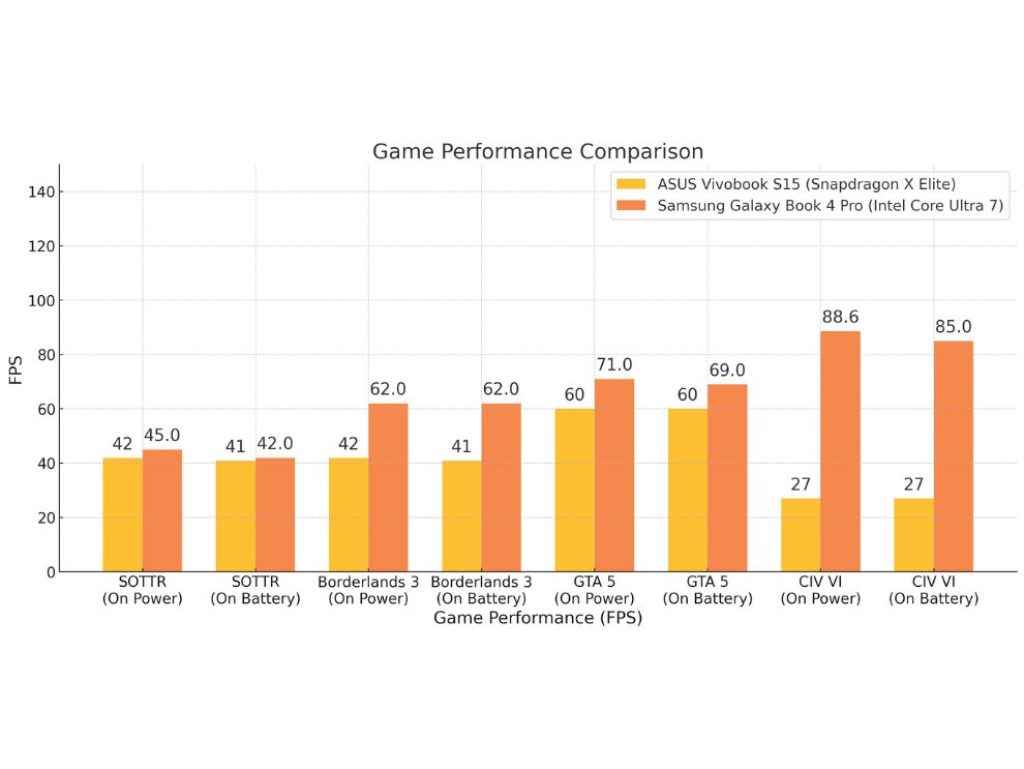
In Borderlands 3, the Galaxy Book 4 Pro again leads significantly when on power, scoring 62 FPS compared to the Vivobook S15’s 42 FPS. However, when on battery, the performance difference remains with the Galaxy Book 4 Pro maintaining 62 FPS, while the Vivobook S15 drops slightly to 41 FPS.
For GTA 5, the Galaxy Book 4 Pro shows higher performance with 71 FPS on power compared to the Vivobook S15’s 60 FPS. On battery, the Galaxy Book 4 Pro scores 69 FPS, slightly decreasing from its powered performance, while the Vivobook S15 remains steady at 60 FPS.
In “Civilization VI,” the Galaxy Book 4 Pro excels with a remarkable 88.6 FPS on power, vastly outperforming the Vivobook S15’s 27 FPS. On battery, the Galaxy Book 4 Pro scores 85 FPS, maintaining high performance, while the Vivobook S15 stays consistent at 27 FPS.
As a result, in terms of gaming, the Snapdragon X Elite-powered ASUS Vivobook S15 falls behind the Intel Core Ultra 7-powered Samsung Galaxy Book 4 Pro in raw FPS numbers.
ASUS Vivobook S15 Snapdragon X Elite Review: Conclusion
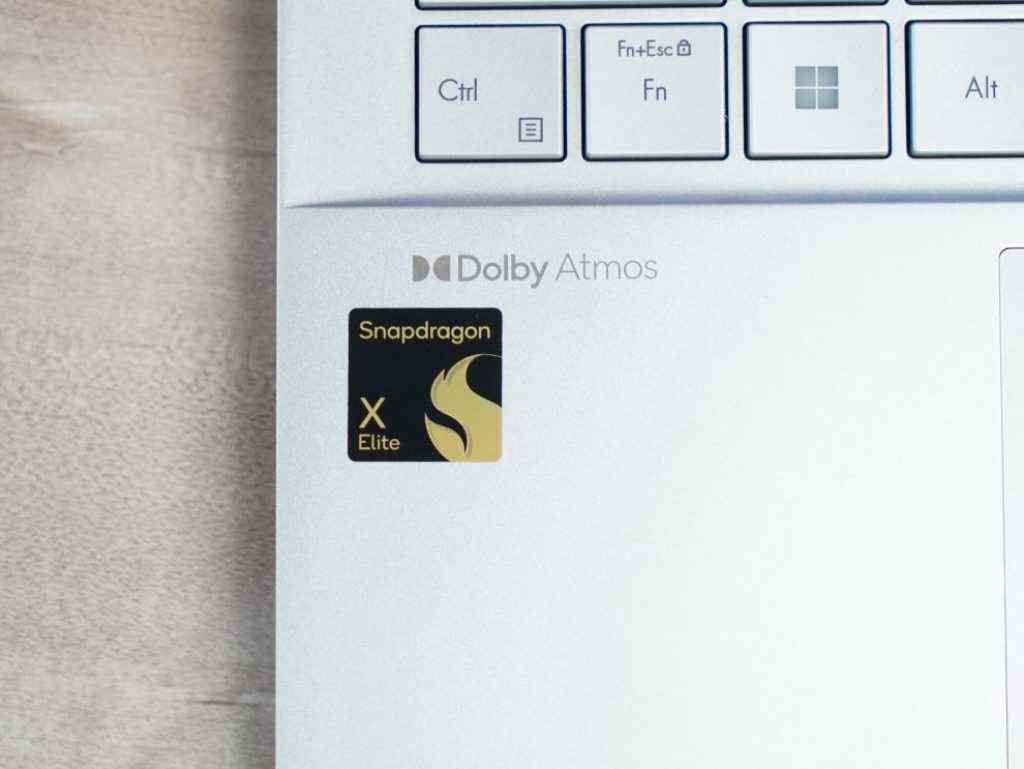
So overall, I have multiple conclusions regarding the new X Elite chip. First, it is fast, but any OEM providing these laptops needs to offer a higher RAM variant considering the memory is unupgradable.
Secondly, these chips provide a snappier experience, good battery life, and consistent performance regardless of whether they are plugged in or not. However, to maintain good performance in both cases, the app needs to be optimized for ARM. If the app is not optimized, you’ll see a small performance drop when plugged in and a more noticeable performance drop when on battery.
Thirdly, app compatibility for basic apps is present, but for many others, support is lacking. For example, a lot of games are not yet supported, and if you’re a developer using apps with native X86/X64 assembly code, you could face issues.
However, the Intel Core Ultra 7 is not far behind in terms of performance and efficiency. It lags in battery life but has absolutely no app compatibility issues. Qualcomm, Microsoft, and other OEMs set out to create a MacBook killer, and they succeeded in making just that. This device is a MacBook killer only, a very specialized device for a specialized use case, which does not include gaming. Unlike the X86 laptops we have nowadays, this is not a Swiss knife, at least for now.
Yetnesh Dubey
Yetnesh works as a reviewer with Digit and likes to write about stuff related to hardware. He is also an auto nut and in an alternate reality works as a trucker delivering large boiling equipment across Europe. View Full Profile
